Israeli strikes on a group of seven journalists in south Lebanon on 13 October, which killed Reuters journalist Issam Abdallah and injured six others, were likely a direct attack on civilians that must be investigated as a war crime, Amnesty International said today.
Amnesty International verified over 100 videos and photographs, analyzed weapons fragments from the site, and interviewed nine witnesses. The findings indicate that the group was visibly identifiable as journalists and that the Israeli military knew or should have known that they were civilians yet attacked them anyway in two separate strikes 37 seconds apart.
“Our investigation into the incident uncovers chilling evidence pointing to an attack on a group of international journalists who were carrying out their work by reporting on hostilities. Direct attacks on civilians and indiscriminate attacks are absolutely prohibited by international humanitarian law and can amount to war crimes,” said Aya Majzoub, Amnesty International’s Deputy Regional Director for the Middle East and North Africa.
“Those responsible for Issam Abdallah’s unlawful killing and the injuring of six other journalists must be held accountable. No journalist should ever be targeted or killed simply for carrying out their work. Israel must not be allowed to kill and attack journalists with impunity. There must be an independent and impartial investigation into this deadly attack.”
Those responsible for Issam Abdallah’s unlawful killing and the injuring of six other journalists must be held accountable. There must be an independent and impartial investigation into this deadly attack.
Aya Majzoub, Amnesty International’s Deputy Regional Director for the Middle East and North Africa
The group of seven journalists had been on a reporting trip to south Lebanon and were wearing helmets and flak vests marked “press”. From around 5pm on 13 October, the group was stationary in the same open location near the village of Alma al-Chaab in the Tyre governorate for about an hour prior to the attack, in full view of Israeli forces on the other side of the border. One of the cars had “TV” plastered on its hood.
An Israeli Apache helicopter, and likely an Israeli drone, hovered above them for more than 40 minutes before the first strike, as can be seen or heard in the journalists’ footage. Israeli forces had observation towers, ground elements, and air assets deployed to closely monitor the border. All of this should have provided sufficient information to Israeli forces that these were journalists and civilians and not a military target.
Amnesty International did not find any indication that there were any fighters or military objectives at the site of the strikes, raising concerns that these strikes were likely direct attacks on civilians.
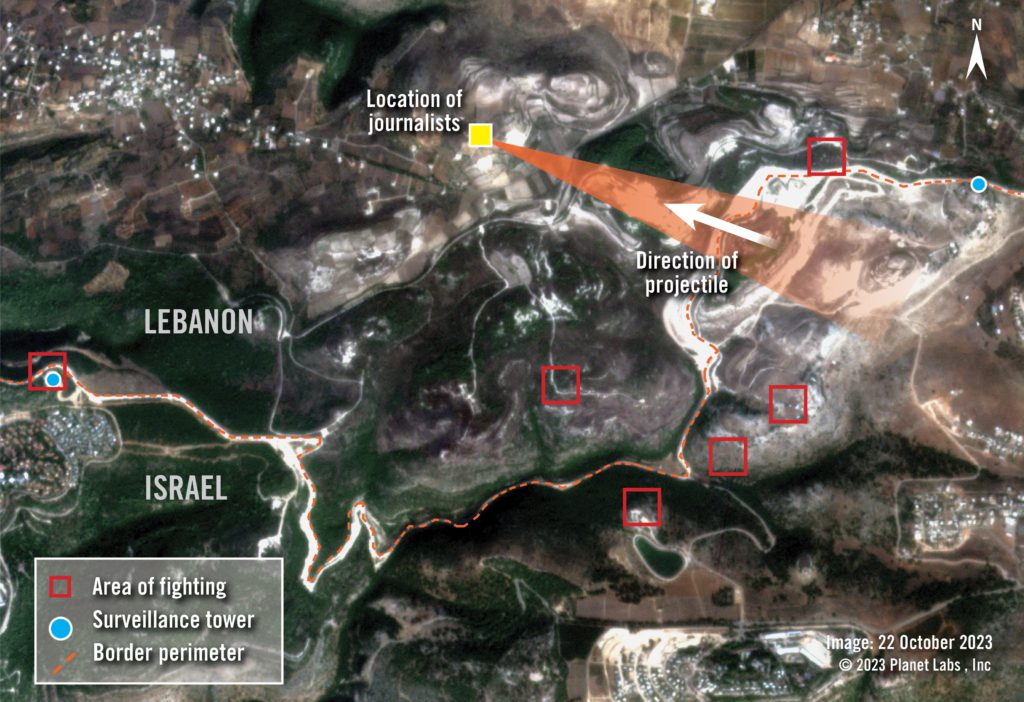
An overview image of the area shows the border perimeter, surveillance towers and areas of fighting recorded by the journalists before they were struck. The direction of the projectile and area from which it originated is also shown
Based on a review of videos and photos from the scene – including analysis of the weapons fragments at the site, injuries the victims sustained, and analysis of two post-blast impact areas on a stone wall beside the road and a nearby crater – Amnesty International determined that the first strike, which killed Issam Abdallah and severely injured AFP videographer and photographer Christina Assi, was a 120mm tank round fired from the hills between al-Nawaqir and Jordeikh in Israel. Just 37 seconds later, the group were struck again, this time by a different weapon, likely a small guided missile, causing an Al Jazeera crew car to go up in flames.
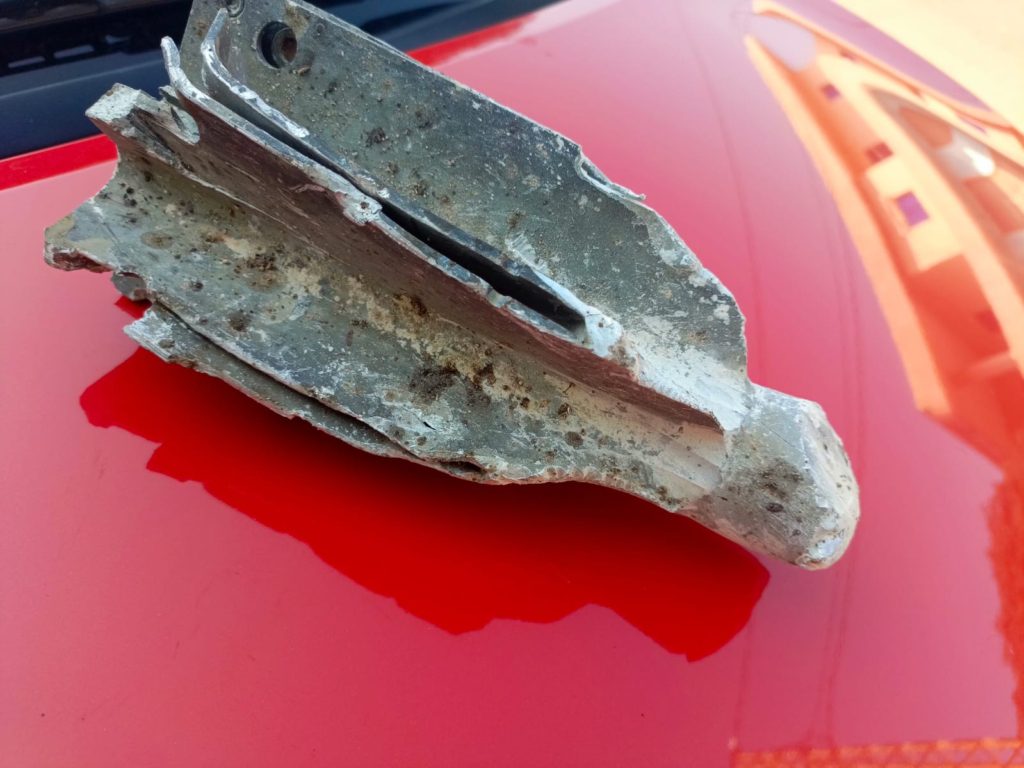
120mm tank round, most likely an M339 projectile, manufactured by the Israeli IMI Systems ©Amnesty International
“Under international humanitarian law, parties to a conflict have a clear obligation to protect civilians – including journalists – and must at all times distinguish between civilians and civilian objects on one hand and fighters and military objectives on the other. During an armed conflict, the role of journalists is particularly important to ensure scrutiny over the conduct of hostilities and highlight possible violations,” said Aya Majzoub.
Methodology
Amnesty International interviewed nine witnesses: three of the journalists hit in the strikes and six others who were in the vicinity of the attack and who heard or saw the strikes and the aftermath.
Amnesty International’s Crisis Evidence Lab verified 57 videos related to the two strikes, primarily filmed by journalists at the scene. This includes 24 videos filmed by journalists before the attack, seven documenting the moment of the attack, and 22 of the aftermath, as well as four other videos that helped corroborate details related to the incident.” The team also analyzed 55 images, including photos of the weapons fragments.
Amnesty International also consulted with Earshot, a non-profit organisation dedicated to audio investigations for human rights advocacy, as well as Steven Beck from Beck Audio Forensics, who conducted sound analysis of the aircraft audible in the journalists’ footage.
On 19 October, Amnesty International sent letters to Lebanon’s Ministry of Defence and to UNIFIL, the UN peacekeeping mission in south Lebanon, requesting information on their investigations into the 13 October attack, as well as the logs of security incidents along the border on that day. Amnesty International’s International Secretariat sent letters to the Israeli military’s spokesperson unit on 28 November and to the Minister of Defense on 2 December regarding this attack. Amnesty International had not received any responses at the time of publication. The organization also reviewed relevant statements by the Israeli military.
The attack on the journalists
On 13 October Issam Abdallah, Reuters photojournalist; Thaier Al-Sudani, Reuters photographer; Maher Nazeh, Reuters photojournalist; Christina Assi, photographer for AFP; Dylan Collins, photojournalist for AFP; Carmen Joukhadar, reporter for Al Jazeera; and Elie Brakhya, photojournalist for Al Jazeera, had gathered in a location close to the village of Alma al-Chaab in south Lebanon to report on ongoing clashes between Israeli forces and Hizbullah.
Exactly 1 minute and 23 seconds before the first strike on them, the journalists turned their cameras to the southwest towards Hanita and started filming an Israeli military post on the border with Lebanon. Footage from three different cameras captured Israeli military infrastructure, such as a watch tower and antennae, and an Israeli Merkava tank firing towards the area of El-Dabche in Lebanon.
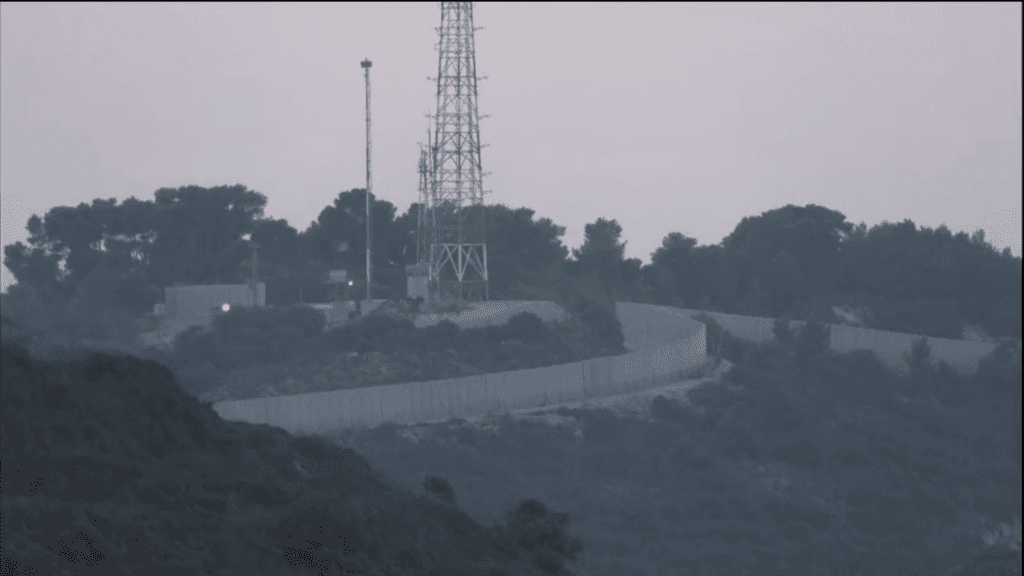
Screengrab from the journalists’ cameras filming an Israeli military post on the border with Lebanon. Footage from three different cameras captured Israeli military infrastructure, such as a watch tower and antennae, and an Israeli Merkava tank firing towards the area of El-Dabche in Lebanon. ©Amnesty International
Seconds later, at 6.02pm, an Israeli tank stationed to the east of the journalists fired the first strike, killing Issam Abdallah, who was sitting on a stone ledge, and severely injuring Christina Assi. A second strike 37 seconds later, using a different weapon, hit the ground near the Al Jazeera car causing it to catch fire.
“I was looking at Issam when we heard the [first] explosion,” Elie Brakhya said. “I saw Issam’s body fly, with the glow and the heat behind his back… [I] ran up the hill, heard Christina shouting ‘I can’t feel my legs’, ran back to where she was, saw Dylan searching for the tourniquet.”
AFP’s Dylan Collins described the distressing scene as he scrambled to assist his injured colleague Christina, after discovering her leg had been severed by the first blast. He told Amnesty International: “As soon as I turned around, I heard Christina’s voice saying, ‘Oh my God!’ I say, ‘You’re okay’. I ran to her directly and I see that her legs are blown off at the kneecap.”
The second blast struck as he attempted to tie a tourniquet around her legs. He said: “When the second blast hit, I was stunned and dizzy, but in my blurry memory, I remember Issam’s leg falling in front of me, I remember looking up and seeing Carmen by the car, her face is black and she is walking like a zombie. Her entire back is covered in shrapnel.”
Carmen Joukhadar told Amnesty International that after the second strike, she saw Elie Brakhya on the ground and thought he was dead. “With a faint voice, I said ‘Elie?’ He replied: ‘Carmen, I’m in pain.’”
As soon as I turned around, I heard Christina’s voice saying, ‘Oh my God!’ I say, ‘You’re okay’. I ran to her directly and I see that her legs are blown off at the kneecap.
Dylan Collins, AFP videojournalist injured in the same attack
Verified videos and photos of the aftermath of the attack show three injured journalists – Christina Assi, Elie Brakhya and Carmen Joukhadar – as well as the body of Issam Abdallah and the burned Al Jazeera car.
Amnesty International reviewed the report issued on 13 October by the Forensic Medicine and Criminal Evidence Department of the Lebanese Ministry of Justice after the examination of Issam Abdallah’s body. The report said that his body sustained severe injuries and burns.
Christina Assi lost one of her legs and was still in hospital at the time of publication. Dylan Collins sustained shrapnel wounds to his face, arms and back. Maher Nazeh sustained shrapnel wounds to his arms, and Thaier al-Sudani sustained shrapnel injuries on the entire left side of his body. Carmen Joukhadar also sustained shrapnel wounds and other injuries particularly on the lower half of her body, and Elie Brakhya sustained severe injuries on both his arms and his shoulder was crushed.
The journalists’ location
The journalists had gathered on 13 October next to a road on a hill close to the village of Alma al-Chaab in the Tyre governorate, about 1km away from the Israeli border. The journalists had gathered in this location in order to film ongoing clashes in Hanita in northern Israel, following a suspected infiltration attempt by Palestinian armed groups and an explosion at the border fence earlier that afternoon, which the Israeli military said “was lightly damaged”. Shortly thereafter, the Israel military announced they had “ruled out” the infiltration attempt but continued to say that “a shooting was identified toward a number of military posts at the Lebanese border” adding that the Israeli military had “responded with tank fire toward” Hizbullah infrastructure and that “artillery fired toward the source of the shooting”.
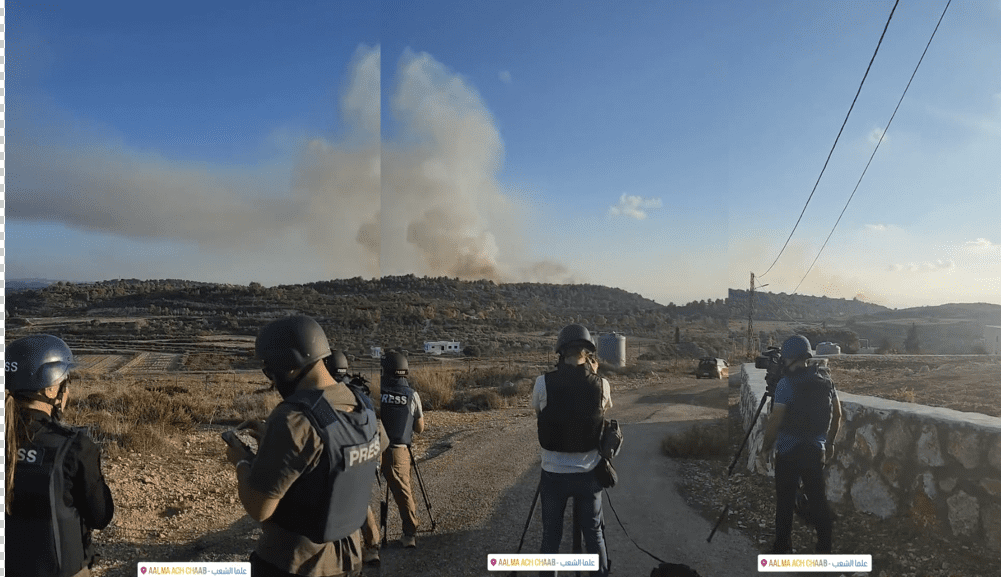
Lebanon’s National News Agency reported that “there was an exchange of fire between the resistance [Hizbullah] and the Israeli enemy” in the border area between the towns of Alma al-Chaab and Dhayra.
Our car was white, we kept all its doors open, on purpose, to announce that we’re journalists on a hill with no military presence, no bushes, no people… We are journalists, so we do not choose suspicious locations; we choose locations that are extremely exposed.
Elie Brakhya, photojournalist for Al Jazeera who was injured in the same attack
Footage from the cameras of the journalists who came under attack reviewed by Amnesty International indicates that they were filming border clashes between Israeli forces and Hizbullah and other armed groups in five different locations, likely in and around the towns of Al-Nawaqir, Adamit and Hanita in Israel, at least 1.5km from their location.
Videos captured by the journalists and verified by Amnesty International show that the media crews were on a hill, set up on a road next to a house, with a broad view of the valley forming the border between Lebanon and Israel. This placed the journalists within a clear line of sight of a variety of Israeli military locations, including in Al-Nawaqir, Jordeikh and Hanita.
Journalists from AFP, Al Jazeera, the Lebanese Broadcasting Corporation (LBC) and Al Jadeed TV told Amnesty International that they had deliberately chosen this location because it is on a hill, allowing them to film and report on the clashes in Hanita, on another hill separated by a valley. The journalists told Amnesty International that following what sounded like gun battles on the Israeli side of the border, the Israeli military started an operation to ensure that they had eliminated the suspected infiltration threat. Videos and images that Amnesty International verified show that the seven journalists were wearing body armor labeled “press”, and that the blue Reuters crew car was marked “TV” with yellow tape on its hood.
Al Jazeera videographer Elie Brakhya described to Amnesty International the precautions the journalists took. “Our car was white, we kept all its doors open, on purpose, to announce that we’re journalists on a hill with no military presence, no bushes, no people, barely a couple of houses, and white sand. We are journalists, so we do not choose suspicious locations; we choose locations that are extremely exposed,” he said.
Carmen Joukhadar, Al Jazeera reporter, added: “We were seven reporters, geared up with press jackets, helmets, three media cars, and several cameras on tripods. In short, we were impossible to miss.”
Surveillance
Footage captured by Al Jazeera, as well as an Alaraby crew that was filming the clashes from another location in Alma al-Chaab, capture an Israeli Apache helicopter flying overhead.
Sound analysis of the footage conducted by Earshot and Steven Beck of Beck Audio Forensics indicates that for over 40 minutes prior to the attack on the journalists, the sound of a circling helicopter and propeller-driven aircraft can be heard. These assets, which were conducting surveillance, were an Israeli Apache helicopter and most likely an Israeli drone.
Footage shot by the journalists also showed an observation tower on the hill in Hanita. The tower overlooks the village of Alma al-Chaab and hosts an Israeli military signals intelligence listening station, responsible for providing forces with real-time intelligence during operations. Further, satellite imagery and footage verified by Amnesty International indicate that similar infrastructure existed in Jordeikh, from which the journalists’ location was also visible.
Origin of the strikes and weapons analysis
Images and videos of the aftermath of the strikes verified by Amnesty International indicate that the first attack originated from the hills between the villages of Al-Nawaqir and Jordeikh in Israel.
Amnesty International analyzed the location of Issam Abdallah’s body after the strikes, the direction in which the stones from the ledge that he was sitting on were dispersed, as well as the direction in which the camera was shaking and fell on the ground following the strike. Analysis of weapons fragments indicates that the munition that killed Issam Abdallah was a 120mm tank round, most likely an M339 projectile, manufactured by the Israeli IMI Systems and identified in other Amnesty International investigations of attacks by the Israeli military.
The analysis indicates it was fired from an Israeli position close to Jordeikh, east of the journalists. Verified footage filmed by journalists on that day confirms that the Israeli military were firing from that area.
The second strike, 37 seconds later, created a small shallow crater near the front tyre of the Al Jazeera vehicle. Based on photos of weapons fragments, this munition was most likely a small guided missile, but Amnesty International was not able to identify the exact model, direction of fire, or launch platform.
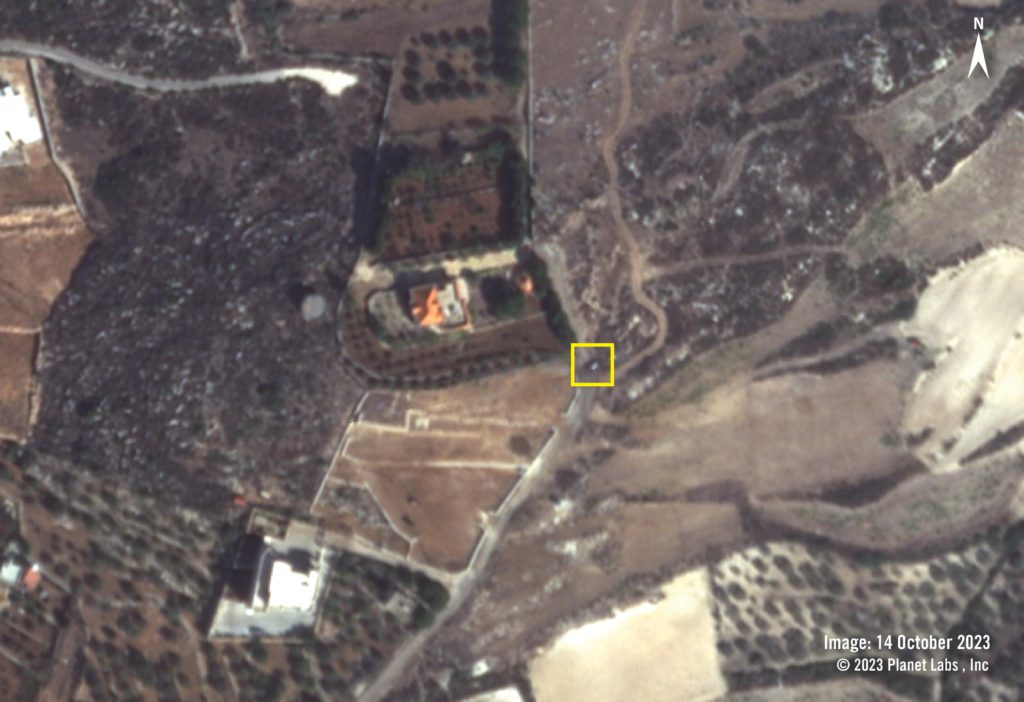
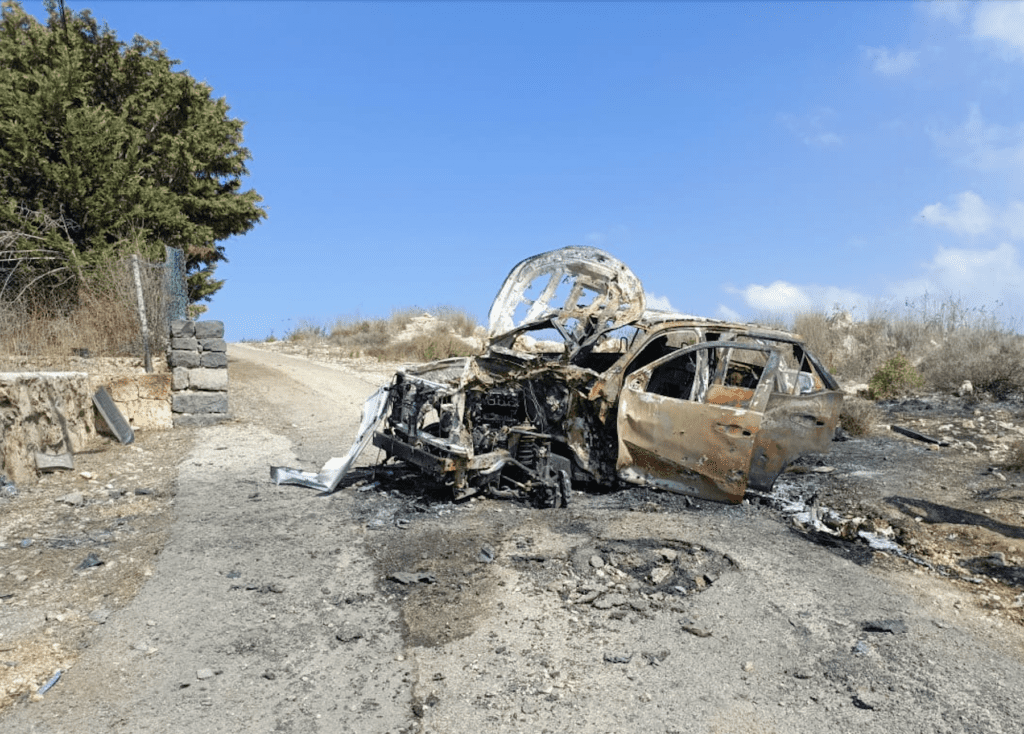
Second crater near the front tyre of the Al Jazeera vehicle
After the attack on 13 October, Israel’s UN envoy Gilad Erdan said in a briefing: “Obviously, we would never want to hit or kill or shoot any journalist… But you know, we’re in a state of war, things might happen.” The next day, the Israeli military said that “the incident is under review”.
Amnesty International and other human rights organizations have documented Israel’s longstanding record of almost total impunity for violations, including suspected war crimes, by its security forces; an independent and impartial investigation is therefore imperative.
In May 2023, the Committee to Protect Journalists highlighted that in the past 22 years, not a single member of the Israeli armed forces has been charged or held responsible for the killing of at least 20 journalists.
In 2000, Amnesty International documented how an Israeli strike in south Lebanon killed Lebanese journalist Abd al-Rahman Taqqush, who was working for the BBC at the time. Israeli authorities have not held those responsible to account.
More recently, Israeli authorities have failed to hold perpetrators accountable for the killing of Palestinian journalist Shireen Abu Akleh, who was shot dead by Israeli forces in the occupied West Bank in 2022.
Background
Three Lebanese journalists covering hostilities in south Lebanon have been killed. In addition to the incident documented here in which Issam Abdallah was killed, on 21 November, three civilians, including two journalists from the local TV station Al Mayadeen – reporter Farah Omar, cameraman Rabih Maamari and their local guide Hussein Akil – were killed in a strike in the village of Teir Harfa in the governorate of Tyre.
Since 7 October, the Committee to Protect Journalists has confirmed the death of at least 63 journalists and media workers – 56 Palestinian, four Israeli, and three Lebanese.
An independent and impartial investigation into these incidents is also needed.
Cross-border hostilities between Israel and Lebanon have escalated significantly since 7 October.
Hizbullah and other armed groups have fired projectiles at northern Israel, killing three Israeli civilians, according to the Israeli military. Amnesty International is investigating attacks by Hizbullah and other armed groups on northern Israel to determine whether they violated international humanitarian law.
According to media reports, Israeli shelling in Lebanon has killed at least 16 civilians so far. Last month, Amnesty International documented the use of white phosphorus artillery shells by the Israeli military in the villages of Dhayra, al-Mari and Aita al-Chaab, some of which may be considered indiscriminate attacks and therefore unlawful. On 14 October, Israeli authorities had denied that they used white phosphorus in their military operations in Gaza and Lebanon.
What you can do
For more ways to take action and further information on the current crisis and Amnesty’s work on Israel and the Occupied Palestinian Territories, check out the action toolkit on our country page.
Top image © Private
